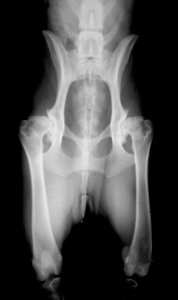Managing Osteoarthritis (OA) in the Dog
What is osteoarthritis (OA) in dogs and can it be treated?
Osteoarthritis (OA) is a very common problem in dogs. It can affect dogs in various ways through the different stages of their life, from being barely noticeable to absolutely debilitating. It is a progressive disease, but its rate of progression will vary based on the cause and how it is managed.
Situational Awareness
The veterinary profession has made great strides in managing OA over the past 20 years, and not simply because we have better drugs! We better understand how to create and maintain joint health, which means we have identified many tools that can be utilized to improve the function and decrease the pain of an arthritic joint.
The term “multimodal treatment approach” is used frequently when discussing OA. Although it might be comforting to know that there are many tools at our disposal to help manage OA, it can also be daunting to figure out how to put it all together.

Learn how to manage OA in the dog!
All the information you need.
Fully narrated surgical videos.
In depth guide and more.
Pre-management Considerations:
- Blood work to show that NSAIDs can be safely used in this patient. The blood work may need to be repeated at regular intervals based on the frequency of NSAID use in the patient.
- Relationships with people in the community who can assist you and your client with various services: e.g. acupuncturist, rehabilitation center, chiropractor, nutritionist/food company.
- Consider empowering your staff to create and run a successful weight loss program within your hospital. Obesity is such a rampant problem in the pet population; programs like these can be helpful for so many patients. Alternatively, find a neighbouring hospital that has a successful weight loss program in place that can help your patient.
What the client needs to know:
- The client will actually be the one managing their pet’s OA under the guidance of the veterinarian and their team.
- A large component of the consultation revolves around understanding OA and how we can help the pet’s quality of life.
- A very good to excellent quality of life is possible for a pet with OA but it will take work and some adjustments along the way. A change of habits may be necessary.
- Although medications are an important component to help manage OA, the goal is to get the pet off the drugs and use other tools to maintain comfort and activity levels.
Get ready to manage OA:

There are many tools available to manage OA but they are not weighted equally.
- This slide depicts the main categories of tools used to manage OA and their importance.
- There is so much to be discussed within each topic but the lifestyle category is an especially vast topic that must fit the individual patient’s needs. Exercise is the cornerstone of OA management.
- Medications that are commonly used for the treatment of OA include: NSAIDs, Tramadol, Amantidine and gabapentin, but not all work well for OA.
- Chondroprotectives (although not medications per se) do play a role in OA management as they can have a positive effect on the patient.
- Modalities such as laser therapy and ultrasound can also be helpful, but there are many more modalities that owners can consider to help manage their pet.
- Surgery is definitely the least important category but it has its place, especially when it comes to hip OA and that of the carpal and hock joints.
What you get when you register
- This workshop consists of a narrated video which goes through the different OA management categories in detail. There are numerous tools offered to help treat these patients but most importantly, the information is tangible and practical so that you can get your patient started in the right direction.
- Commonly used medications are discussed as to whether they really work and how to use them. The same applies to Chondroprotectives: various modalities and surgeries. The information in this workshop is a combination of evidence based research, results from randomized clinical trials but also years of experience managing such cases. Successful management of OA is so much more than just using the correct medications and modalities in the correct way.
- I discuss how I specifically tend to manage OA cases of different levels of severity. My goal with the case examples is to give you a template that you can then adjust to suit you best.

Q & A
How long do dogs live with OA?
Dogs with properly managed OA can have a normal life expectancy.
What is a pet’s quality of life (QoL) with OA?
The quality of life can be very good to excellent when OA is properly managed. Depending on the pet’s lifestyle and the severity of the OA, some changes to the expected daily activity may be necessary.
Workshop Content
Workshops & Courses
Blog
 The Secret to having the Bandage stay Above the StifleJuly 3, 2024 - 1:44 pm
The Secret to having the Bandage stay Above the StifleJuly 3, 2024 - 1:44 pm Common Mistakes made by Veterinarians when doing the Drawer TestJune 26, 2024 - 9:22 am
Common Mistakes made by Veterinarians when doing the Drawer TestJune 26, 2024 - 9:22 am Burying the end knot in a continuous subcutaneous suture patternJune 19, 2024 - 7:35 pm
Burying the end knot in a continuous subcutaneous suture patternJune 19, 2024 - 7:35 pm Creating Donuts for your BandagesJune 12, 2024 - 3:15 pm
Creating Donuts for your BandagesJune 12, 2024 - 3:15 pm The Knotless Suture PatternJune 5, 2024 - 2:45 pm
The Knotless Suture PatternJune 5, 2024 - 2:45 pm

